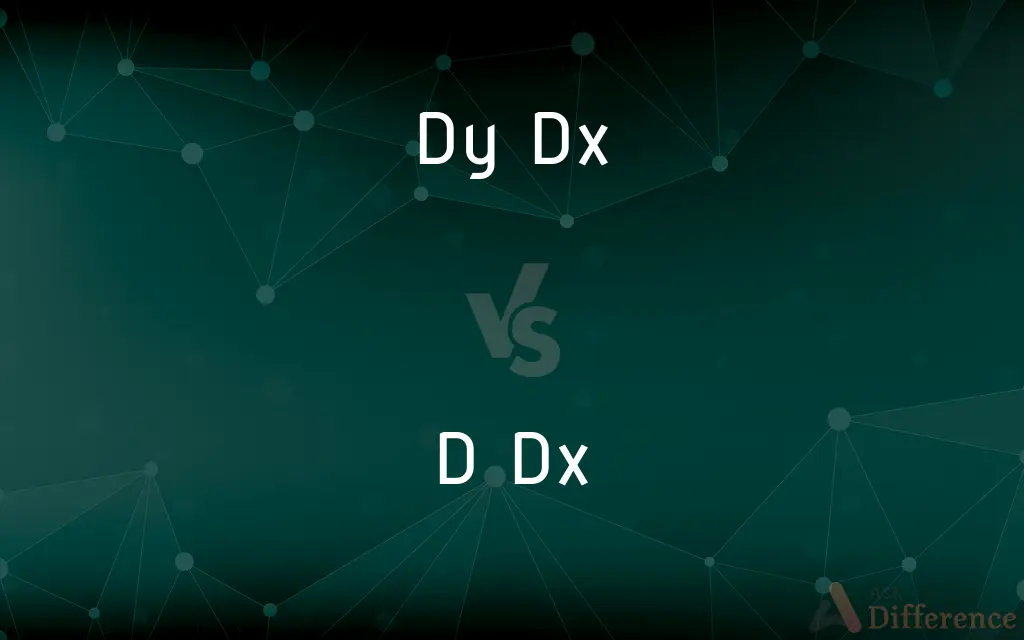dy dx vs. d dx — What's the Difference?
Edited by Tayyaba Rehman — By Fiza Rafique — Published on December 23, 2023
"dy/dx" represents the derivative of y with respect to x, while "d/dx" is a differentiation operator applied to a function.

Difference Between dy dx and d dx
Table of Contents
ADVERTISEMENT
Key Differences
"dy/dx" specifically denotes the rate of change of the function y as x changes. On the other hand, "d/dx" is an operator indicating that a function needs to be differentiated with respect to x.
Both "dy/dx" and "d/dx" are symbols in calculus that have their roots in the concept of a derivative. However, while "dy/dx" already states which function is being derived, "d/dx" stands alone until paired with a function.
Practically speaking, if you're given a function y(x) and you're asked to find its derivative, the result will be represented by "dy/dx." Yet, if you're told to differentiate a function, the instruction might be given as "d/dx" of that function.
To summarize, "dy/dx" directly gives you the rate of change of y with respect to x, while "d/dx" is an instruction to differentiate a provided function concerning x.
Comparison Chart
Nature
Result of differentiation
Differentiation operator
ADVERTISEMENT
Representation
Derivative of y with respect to x
Awaiting a function to differentiate
Context
Already specifies function (y) being derived
Needs a function to act upon
Usage
Tells rate of change of y
Indicates action of differentiation
Completeness
Complete in itself
Stands alone until paired with a function
Compare with Definitions
Dy Dx
Slope of the tangent to y at any point x.
For y = sin(x), dy/dx gives the slope of sine curve at each point.
D Dx
A command to find the derivative concerning x.
If you see d/dx preceding g(x) = ln(x), it's instructing you to find the derivative of ln(x).
Dy Dx
Measure of sensitivity of y to changes in x.
In economics, if y is revenue and x is price, dy/dx can represent price elasticity.
D Dx
Symbol of differentiation in calculus.
In problems, d/dx paves the way for determining how functions behave as variables change.
Dy Dx
Rate at which y changes as x changes.
For a distance-time graph, dy/dx represents speed.
D Dx
Represents the action of finding the rate of change concerning x.
When faced with d/dx of h(x) = tan(x), you're finding how tan(x) changes with x.
Dy Dx
Gradient of function y.
For y = e^x, dy/dx is also e^x, meaning the function grows at the rate it's increasing.
D Dx
Stands alone until given a function to act upon.
The expression d/dx by itself is incomplete without a function to differentiate.
Dy Dx
Represents the derivative of function y concerning x.
If y = x^2, then dy/dx = 2x.
D Dx
Operator indicating differentiation with respect to x.
For f(x) = x^3, d/dx of f(x) gives 3x^2.
Common Curiosities
Is "d/dx" specific to any function?
No, it's a general operator; the function it acts upon is provided separately.
What does "dy/dx" mean in calculus?
It represents the derivative of the function y with respect to x.
Does "d/dx" always need a function to be complete?
Yes, "d/dx" by itself is an instruction; it needs a function to differentiate.
Can "dy/dx" stand alone in equations?
Typically, "dy/dx" is the result of a differentiation process, so it's associated with a specific function y.
Why are both "dy/dx" and "d/dx" essential in calculus?
"dy/dx" gives specific rate changes, while "d/dx" is a tool to find those rates for various functions.
Do both symbols have roots in the concept of limits?
Yes, the foundation of derivatives, which both symbols represent, is the limit concept.
How can I interpret the result of "dy/dx"?
It gives the rate of change or slope of y concerning x at a specific point.
Can I consider "dy/dx" a fraction?
While it resembles a fraction and can sometimes be manipulated like one, it symbolizes the rate of change.
How does "d/dx" relate to integrals?
Differentiation (d/dx) and integration are inverse operations in calculus.
Can "d/dx" act on multivariable functions?
Typically, it acts on single-variable functions. For multivariables, partial derivatives are used.
Is "d/dx" an operation?
Yes, it's an operator indicating the action of differentiation.
In which fields is "dy/dx" commonly used?
Physics, economics, biology, and many other fields use it to represent rates of change.
Are there other operators like "d/dx" for other variables?
Yes, for differentiation with respect to other variables, you might see symbols like "d/dt" or "d/dz".
How does "dy/dx" relate to graphs?
It gives the slope of the tangent to the curve at any given point.
Share Your Discovery

Previous Comparison
QHD vs. IPS
Next Comparison
Purchase Book vs. Purchase AccountAuthor Spotlight
Written by
Fiza RafiqueFiza Rafique is a skilled content writer at AskDifference.com, where she meticulously refines and enhances written pieces. Drawing from her vast editorial expertise, Fiza ensures clarity, accuracy, and precision in every article. Passionate about language, she continually seeks to elevate the quality of content for readers worldwide.
Edited by
Tayyaba RehmanTayyaba Rehman is a distinguished writer, currently serving as a primary contributor to askdifference.com. As a researcher in semantics and etymology, Tayyaba's passion for the complexity of languages and their distinctions has found a perfect home on the platform. Tayyaba delves into the intricacies of language, distinguishing between commonly confused words and phrases, thereby providing clarity for readers worldwide.
















































